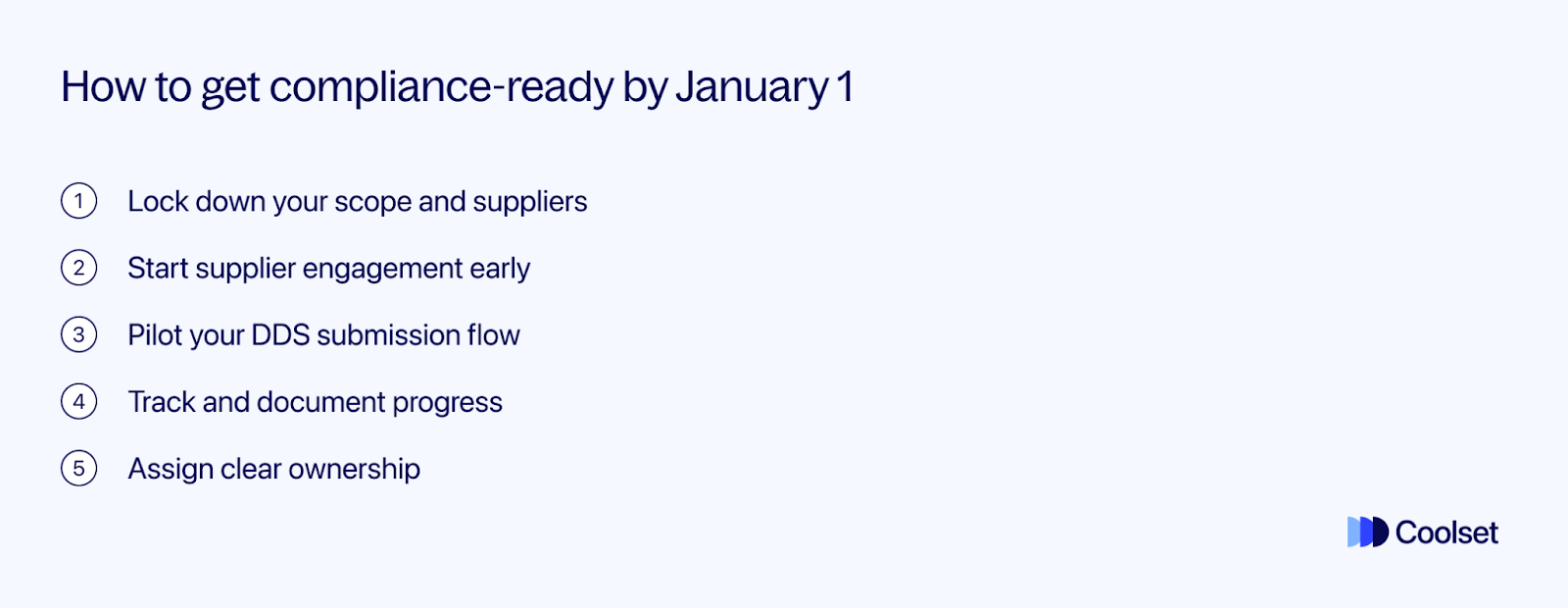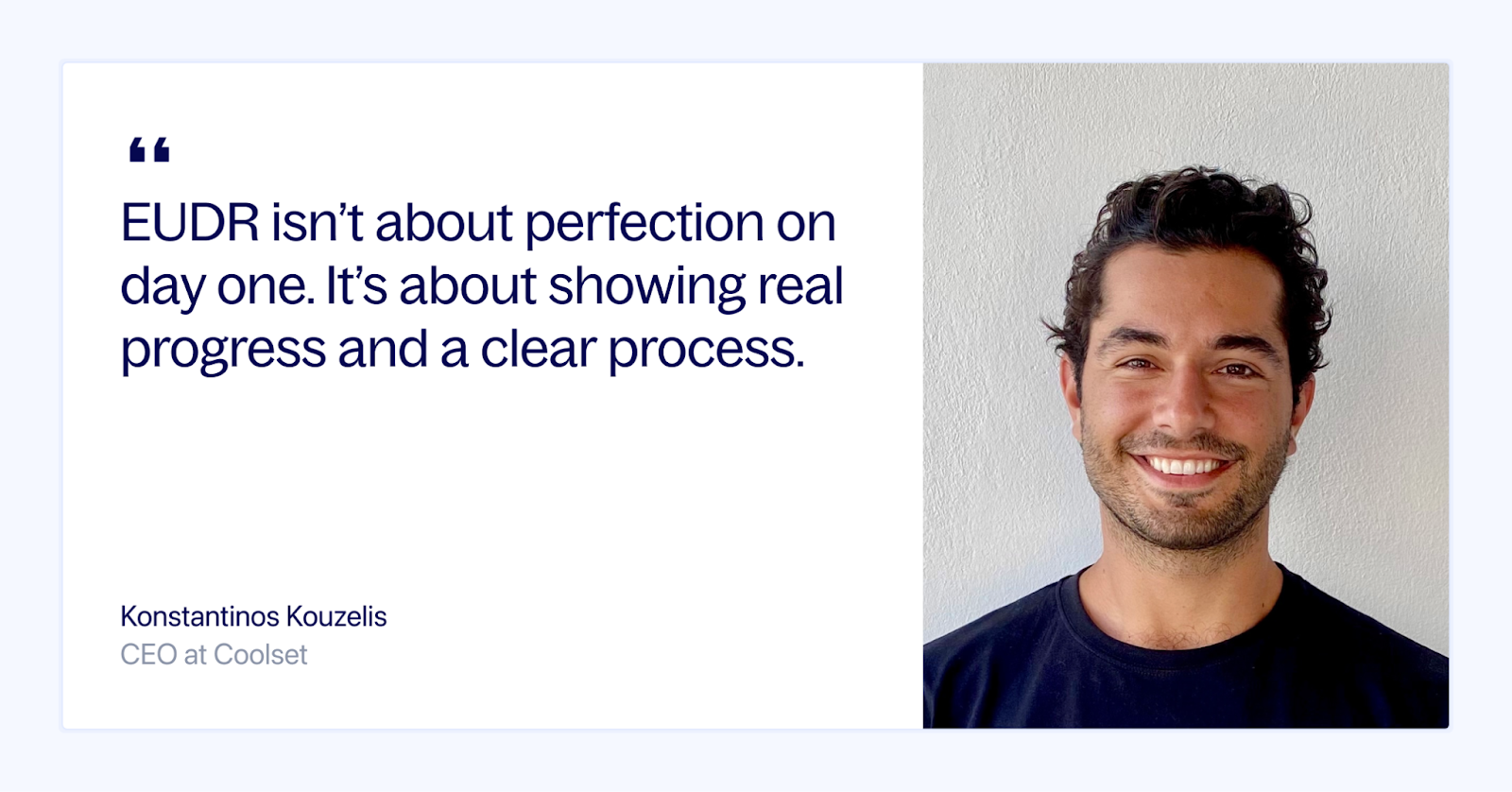Disclaimer: Latest EUDR developments
On 21 October, the European Commission proposed targeted changes to the EU Deforestation Regulation (EUDR). These adjustments aim to make the rollout smoother without changing the regulation’s overall goals.
Key points from the proposal:
We're closely monitoring the development and will update our content accordingly. In the meantime, read the full explainer here.
During our recent EUDR readiness webinar, Coolset’s research team confirmed that despite speculation, no general delay to the EU Deforestation Regulation (EUDR) has been approved.
The European Parliament continues to debate certain details, but until any legislative changes are formally adopted, companies should assume the current timeline still stands: operators and traders must comply from December 30, 2025, with full enforcement for micro and small primary operators following December 30 2026.
As discussed in the session, much of the confusion comes from headlines about a “delay.” In reality, this refers only to a six-month grace period on penalties for large and medium operators (not on compliance itself).

The message from our experts was clear: don’t panic, but don’t pause. The regulation is still moving forward behind the scenes, and the companies taking proactive steps now will be best positioned to avoid disruption and demonstrate credibility to customers, investors, and regulators.
This article summarizes our recent webinar’s key guidance into five short-term actions sustainability, procurement, and compliance teams can take to show progress and stay ahead of enforcement.
For large and medium-sized companies, the compliance deadline remains December 30, 2026, while small and micro enterprises will follow a year later.
Although the European Commission has floated proposals to smooth enforcement, these are focused on giving national authorities and companies more time to adapt to new IT systems and processes, not on changing the core regulation itself.
The intent is to make the rollout more practical, for example by phasing in TRACES access, delaying penalties, or offering clearer guidance on risk classification, while keeping the original compliance dates intact.
With the deadline approaching, there are five practical steps to demonstrate progress and reduce compliance risk, even as the details of enforcement evolve.
Remember: You don’t need perfection by January 1, just a defendable process.

Confirm which products fall under Annex I and identify their HS codes. Then map your key suppliers, prioritizing the suppliers or commodities that make up the majority of your import volume or risk exposure.
Begin by explaining why this data is needed. We recommended using simple templates or translation support to help suppliers share coordinates and legality documents without friction. Don’t wait for TRACES access, data gathering can start now.
Run a small-scale test of your Due Diligence Statement (DDS) with one or two representative shipments. Even if the TRACES portal isn’t yet open, simulate the process internally to identify missing fields and communication gaps between procurement and compliance.
Create a basic dashboard or spreadsheet to track supplier responses, DDS completeness, and data quality. This becomes your evidence base showing “reasonable steps” toward compliance if authorities request proof of preparation.
Designate one person or small team responsible for coordinating EUDR readiness across data collection, verification, and DDS sign-off. Embedding this responsibility within your ESG or internal control process helps prevent last-minute confusion.
{{product-tour-injectable}}
With less than two months to go, companies should focus on collecting the minimum viable information that proves traceability and legality for each in-scope shipment. The goal isn’t to have flawless datasets, it’s to show a clear, defensible process.
Start small: trace one or two complete supply chains end-to-end to test your data flow. Even if formats or templates evolve, focus on keeping records consistent, verifiable, and linked to supplier identities.

Use public tools like FAO Forest Watch to check land-use data and the TRACES sandbox (when available) to understand submission workflows. You can reach out to your national competent authority for country-specific compliance guidance.
Coolset’s EUDR module can also help you manage supplier input, automate version tracking, and ensure data remains audit-ready.
Put simply: Excel won’t get you through EUDR. Manual tracking using spreadsheets might work for a handful of suppliers, but it quickly breaks down when dealing with hundreds or thousands of data points.
Digital compliance tools can save weeks of preparation time by automating traceability mapping, supplier communication, and DDS generation, all within a single system. The goal isn’t to add another layer of software, but to make data collection faster, clearer, and audit-ready.
With Coolset’s EUDR compliance platform:
When evaluating tools, we recommended focusing on:
These features will help your teams reduce back-and-forth communication, minimize data errors, and maintain continuous compliance.
You can see Coolset’s EUDR platform in action by booking a demo today.
Let’s take a look at some of the most common uncertainties raised in the webinar around EUDR readiness.
Any delay would simply shift timelines, not the core requirements. All preparation you’re doing now, from supplier onboarding to DDS drafts, remains valid under any updated schedule.
No. Submissions will only be required once the TRACES portal officially opens for EUDR. However, we encourage companies to prepare draft DDS files internally and run mock submissions now to be ready for upload on day one.
Yes. If a supplier or upstream operator has already created a DDS for the same batch, you can reference their statement ID rather than duplicate it. But remember: each operator remains responsible for confirming the accuracy and completeness of their own records.
Geolocation is a legal requirement, not a company preference. We recommend explaining this clearly and offering practical support. For example, through a platform like Coolset, which provides localized onboarding and step-by-step guidance. If suppliers remain unresponsive, the only real option is to change suppliers.
Learn how to comply with the EUDR in 4 live sessions
.webp)
Track shipments, trace origins, and submit due diligence statements.
